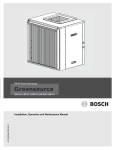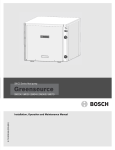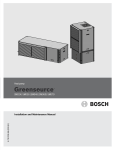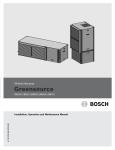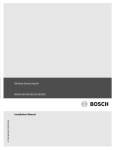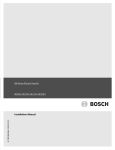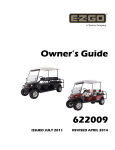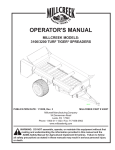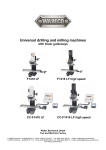Download Bosch TW Series Specifications
Transcript
Installation and Maintenance Manual 6 720 220 047 Revised 03-11 TW Series Water to Water ©Copyright 2011 Bosch, Inc All rights reserved TW Series / Water to Water 3 Table of Contents Table of Contents Model Nomenclature..................................................................................... 3 Initial Inspection........................................................................................... 4 Installation.................................................................................................... 4 Electrical....................................................................................................... 5 Piping........................................................................................................... 5 Cooling Tower / Boiler Applications.............................................................. 6 Well Water Systems....................................................................................... 7 Earth Coupled Geothermal Systems............................................................. 7 Typical Load Side Applications...................................................................... 7 Water to Water Unit Controller...................................................................... 8 Modes Of Operation..................................................................................... 8 Unit Protection.............................................................................................. 9 User Adjustable Setting Chart..................................................................... 11 Setting Up The Controller........................................................................... 11 Initial Configuration.................................................................................... 12 System Check-Out...................................................................................... 13 Unit Start-Up............................................................................................... 13 Heat Recovery Package............................................................................... 14 Operating Pressures................................................................................... 16 Chiller Mode........................................................................................... 16 Boiler Mode............................................................................................ 16 Wiring Diagrams.......................................................................................... 17 Two Phase - Single Stage........................................................................ 17 Two Phase - Single Stage Solid State Unit Controller.............................. 18 Unit Check-Out........................................................................................... 19 Trouble Shooting......................................................................................... 20 Model Nomenclature TW 060 - 3 CS C - F X X MODEL: TW=WATER TO WATER R-410A NOT APPLICABLE NOMINAL CAPACITY: THOUSANDS OF BTUH - COOLING VOLTAGE DESIGNATIONS: WATER CONNECTION LOCATION 1- 208-230/1/60 F-FRONT CONTROL OPTIONS: CS: WATER-TO-WATER UNIT NO CONTROLS WATER COIL OPTIONS US: WATER-TO-WATER UNIT MOUNTED CONTROLLER C-COPPER N-CUPRO-NICKEL Revised 03-11 Subject to change without prior notice 6 720 220 047 4 TW Series / Water to Water Initial Inspection Be certain to inspect all cartons or crates on each unit as received at the job site before signing the freight bill. Verify that all items have been received Caution and that there is no visible damage; note any shortages or damage on all copies of the freight bill. In the event of damage or shortage, remember that the purchaser is responsible for filing the Caution necessary claims with the carrier. Concealed damage not discovered until after removing the units from the packaging must be reported to the carrier within 24 hours of receipt. General Description The Water-to-Water series unit is a heat pump that provides the best combination of performance and efficiency available. Safety devices are built into each unit to provide the maximum system protection possible when the unit is properly installed and maintained. The Water-to-Water series units are Underwriters Laboratories (UL) and (cUL) listed for safety. The Water-to-Water series units are designed to operate with entering source liquid temperature between 25° F and 110° F. (see specifications data sheets for limits). For well water applications, the minimum source EWT is 50˚ F, with sufficient water flow to prevent freezing. Antifreeze solution is required for all closed loop applications. Cooling Tower/Boiler and Earth Coupled (Geo Thermal) applications should have sufficient antifreeze solution to protect against extreme conditions and equipment failure. Frozen water coils are not covered under warranty. Initial Inspection components. Only trained and qualified personnel should install, repair, or service the equipment. Before performing service or maintenance operations on the system, turn off main power to the unit. Electrical shock could cause personal injury or death. TW Series R-410A refrigerant systems operate at higher pressures than standard R-22 systems. Do not use R-22 service equipment or components on R-410A equipment. When working on equipment, always observe precautions described in the literature, tags, and labels attached to the unit. Follow all safety codes. Wear safety glasses and work gloves. Use a quenching cloth for brazing, and place a fire extinguisher close to the work area. Location The unit should be centrally located with respect to the distribution system. The unit should be installed in an indoor area that allows easy removal of the access panels, and has enough room for service personnel to perform maintenance or repair. Provide sufficient room to make fluid, and electrical connections. These units are not approved for outdoor installation; therefore, they must be installed inside the conditioned structure. Do not locate in areas that are subject to freezing. Installation The Water-to-Water series unit should be mounted level on a vibration absorbing pad slightly larger than the base to minimize vibration transmission to the building structure. It is not necessary to anchor the unit to the floor. Moving and Storage If the equipment is not needed for immediate installation upon its arrival at the job site, it should be left in its shipping carton and stored in a clean, dry area. Units must only be stored or moved in the normal upright position as indicated by the “UP” arrows on each carton at all times. Safety Considerations Installation and servicing of this equipment can be hazardous due to system pressure and electrical 6 720 220 047 VIBRATION PAD FULL SIZE If the unit is installed on a floor over a crawl space, it should not rest on long, unsupported floor joists. Vibrations may be created in the joists with the crawl space acting as an amplifier box resulting in undesirable noise. A drain pan is recommended Subject to change without prior notice Revised 03-11 Minimal System Volume where water released during start-up or maintenance could cause damage below the unit. MINIMAL SYSTEM VOLUME Bosch recommends that the total fluid volume in the system be not less than 6 gallons per nominal ton of cooling capacity on both the load and source sides. ELECTRICAL Always disconnect power to the unit before servicing to prevent injury or death due to electrical shock. n All field wiring must comply with local and national fire, safety and electrical codes. Power to the unit must be within the operating voltage range indicated on the unit’s nameplate. On three phase units, phases must be balanced within 2%. Properly sized fuse or HACR circuit breakers must be installed for branch circuit protection. See equipment rating plate for maximum size. The unit is supplied with an opening for attaching conduit. Be certain to connect the ground lead to the ground lug in the control box. Connect the power leads as indicated on the unit wiring diagram (Refer to Figure #6). TW Series / Water to Water 5 PIPING Supply and return piping must be as large as the unit connections on the heat pump (larger on long runs). Never use flexible hoses of a smaller inside diameter than that of the water connections on the unit. The Water-to-Water series units are supplied with either a copper or optional cupronickel condenser. Should your well driller express concern regarding the quality of the well water available or should any known hazards exist in your area, we recommend proper testing to assure the well water quality is suitable for use with water source equipment. In conditions anticipating moderate scale formation or in brackish water a cupro-nickel heat exchanger is recommended. Galvanized pipe or fittings are not recommended for use with these units due to the possible galvanic corrosion. Both the supply and discharge water lines will sweat if subject to low water temperature. These lines should be insulated to prevent damage from condensation. All manual flow valves used in the system must be ball valves. Globe and gate valves must not be COOLING TOWER/BOILER APPLICATION (SOURCE SIDE) 1. BALL VALVES 2. HOSE KITS 3. P/T PLUGS 4.load side connections* 5.LOW VOLTAGE CONTROL CONNECTION* 6.vibrAtion pad 7.line voltage disconnect 8.SUPPLY AND RETURN LINES OF CENTRAL SYSTEM Figure #1 * NOTE: Water and electrical connection locations vary depending on model. Connect as required per unit labels. Revised 03-11 Subject to change without prior notice 6 720 220 047 n 6 TW Series / Water to Water used due to high pressure drop and poor throttling characteristics. Never exceed the recommended water flow rates. Serious damage or erosion of the water to refrigerant heat exchanger could occur. Improper heat exchanger fluid flow due to piping, valving or improper pump operation is hazardous to the unit and constitutes abuse which will void the heat exchanger and compressor warranty. Always check carefully for water leaks and repair appropriately. Units are equipped with female pipe thread fittings. Consult the specification sheets for sizes. Thread sealant should be used when connecting water piping connections to the units to insure against leaks and possible heat exchanger fouling. Do not overtighten the connections. Flexible hoses should be used between the unit and the rigid system to avoid possible vibration. Ball valves should be installed in the supply and return lines for unit isolation and unit flow balancing. COOLING TOWER / BOILER APPLICATION (Figure #1) To assure adequate cooling and heating performance, the cooling tower and boiler fluid loop temperature should be maintained between 50° F to 100° F. In the cooling mode, heat is rejected from the unit into the condenser water loop. A cooling tower provides evaporative cooling Cooling Tower / Boiler Application to the loop water; thus, maintaining a constant supply temperature to the unit. When utilizing an open cooling tower, chemical water treatment is mandatory to ensure the water is free of corrosive materials. A secondary heat exchanger (plate frame between the unit and the open cooling tower) may also be used. It is imperative that all air is eliminated from the closed loop side of the heat exchanger to prevent condenser fouling. In the heating mode, heat is absorbed from the condenser water loop to the unit. A boiler can be utilized to maintain the loop within the proper temperature range. In milder climates a “flooded tower” concept is often used. This concept involves adding make-up water to the cooling tower sump to maintain the desired loop temperature. No unit should be connected to the supply or return piping until the water system has been completely cleaned and flushed to remove any dirt, piping chips or other foreign material. Supply and return hoses should be connected together during this process to ensure the entire system is properly flushed. After the cleaning and flushing has taken place, the unit may be connected to the water loop and should have all valves wide open. Pressure/temperature ports are recommended in both the supply and return lines for system flow balancing. Water flow can be accurately set by measuring the refrigerant-to-water heat exchangers WELL WATER APPLICATION (SOURCE SIDE) 1. PRESSURE TANK 2. BALL VALVES 3. SOLENOID VALVE (SLOW CLOSING) 4. HOSE KIT 5. P/T KIT Figure #2 6. LOAD SIDE CONNECTIONS* * NOTE: Water and electrical connection locations vary depending on model. Connect as required per unit labels. 8. VIBRATION PAD 9. LINE VOLTAGE DISCONNECT 6 720 220 047 7.LOW voltage CONTROL CONNECTION* Subject to change without prior notice Revised 03-11 Well Water Systems TW Series / Water to Water 7 water side pressure drop. See specification sheets for water flow and pressure drop information. WELL WATER SYSTEMS (Figure #2) Water quantity should be plentiful, between 1.5 and 3.0 gpm per ton of cooling, and of good quality. To avoid the possibility of freezing in the heating mode, the well water should be above 50˚F. Water pressure must always be maintained in the heat exchanger by placing a water control valve on the outlet of the water-to-water unit. A bladder type expansion tank may be used to maintain pressure on the system. All solenoid valves should be slow closing to avoid water hammer. The discharge water from the water-to-water unit is not contaminated in any manner and can be disposed of in various ways depending on the local codes (i.e. discharge well, dry well, storm sewer, drain field, stream, pond, etc.) Pilot operated or slow closing valves are recommended to reduce water hammering. EARTH COUPLED GEOTHERMAL SYSTEMS (Figure #3) Closed loop and pond applications require specialized design knowledge. No attempt at these installations should be made unless the dealer has received specialized training. Utilizing the Ground Loop Pumping Package (GLP), makes the installation easy. Anti-freeze solutions are utilized when entering loop temperatures drop below 50˚F or where piping will be routed through areas subject to freezing. A flow rate between 2.5 to 3.0 gpm per nominal ton of cooling is recommended for this application. See GLP Pump Curve for sizing information. TYPICAL LOAD SIDE APPLICATIONS There are many load side applications for which the water-to-water heat pump/ liquid chiller is ideally suited. Some typical uses are as follows Hydronic baseboard heating, hydronic in-slab floor heating, forced air fan coil heating or cooling, ice and snow melting, heating potable water, (when allowed by code) heating swimming pool and spa*, process fluid heating or cooling. When specifying load side fluid volume it is important to consider the heat pump output capacities and flow rates. Insufficient load side fluid volume may cause unstable heat pump operation (short cycling). Pressure/temperature ports should be used to set flow rates. EARTH COUPLED APPLICATION (SOURCE SIDE) 1.POLYBUTYLENE OR POLYETHELENE WITH INSULATION 2.GROUND LOOP PUMPING PACKAGE (GLP) 3. GROUND LOOP CONNECTION KIT 4. P/T PLUGS 5. LOAD SIDE CONNECTIONS* 6.LOW VOLTAGE CONTROL CONNECTION* 7. VIBRATION PAD 8. LINE VOLTAGE DISCONNECT Figure #3 * NOTE: Water and electrical connection locations vary depending on model. Connect as required per unit labels. Revised 03-11 Subject to change without prior notice 6 720 220 047 8 TW Series / Water to Water *A water-to-water series Heat Pump/Liquid Chiller can be utilized for direct pool/spa heating without a secondary heat exchanger. In this application cupro-nickel heat exchangers must be used. Automatic chemical feeders must never be installed up stream of the unit. An external bypass should be installed to avoid over-flowing the heat exchanger to prevent coil erosion. The pool pH levels and chemical balances must be maintained to avoid possible heat exchanger damage. Water to Water Unit Controller (OPTIONAL) Bosch’s water to water heat pump controller offers a low cost, simple solution to the control of a water to water heat pump unit. The control is configurable to provide cooling only, heating only or auto change over control strategies based on the application of the unit in a given system. Water to Water Unit Controller • Brown out low voltage protection All of the unit’s safeties are tied back into the controller for system protection. Unit Sensors The unit controller is provided with two sensors: Water Sensor: This sensor will control unit operation in the cooling or heating mode based on the water temperature on the load side. It may be field mounted for example on the return water line or in a water tank when provided with a field supplied immersion well. The location will depend on the specific requirements of the job. Features: Changeover Sensor: This sensor will put the unit in either the heating or cooling mode depending on the set point. It may be mounted in a location that would be indicative if the unit should be in either the heating or cooling mode, for example outdoors. The sensor may be located up to 1000 feet from the unit (additional field supplied wiring required). • Selectable mode of operation. Cooling, Heating or Auto Changeover. Modes of Operation • Adjustable temperature differential for heating and cooling set point. • Adjustable auto changeover set point with adjustable dead band setting. • Intelligent auto reset of a fault condition avoids nuisance hard lockouts. • LED display of control temperature and set points. • ˚F or ˚C Display. • 50\60 Hertz operation. • Pump operation configurable for continuous or cycling operation with the compressor. • Compressor lead-lag operation on units with dual compressors. • Malfunction output and service LED can be set to steady or pulsing to indicate fault condition. • Color LED’s indication of mode of operation. • Set point retention in non volatile memory in the event of a power failure. • Five minute delay on break or power interruption for compressor short cycling protection. 6 720 220 047 The controller will memorize the last mode used before power is removed and will run in that mode after it is turned on. In all modes the control will display temperature degree differential setting for five seconds once it is powered and this setting may be adjusted during this time. Thereafter the display will switch to the monitored water temperature. When switching from one mode to another the set point (the decimal point is used to distinguish it from water temperature) for the new mode is displayed for 5 seconds and then monitored water temperature. During this time the set point may be adjusted. Off Mode In the OFF mode all outputs are disabled and mode indication LED’s will be off. The control will first display temperature differential setting with the ability for the user to adjust it and then will display “OFF” and finally water temperature. Heating Mode When the unit is operated in the heating mode and the controlled water temperature is below the set point minus the differential setting, terminal Y1 will close and the unit will operate (first stage Subject to change without prior notice Revised 03-11 TW Series / Water to Water 9 Cooling Mode compressor in a two stage unit). When the set point is satisfied the compressor is turned off. In a two stage unit after the first stage activation if the water temperature drops an additional two degrees below the set point, the second stage (terminal Y2) will be activated (if control is configured for both compressors). Both stages will be on until the set point is satisfied. When the unit runs after power is applied or the mode is changed from cooling to heating, if the fluid temperature is below set point and doesn’t change for 3 minutes, the second stage of heating will be activated. This only applies for a two stage machine. There will be 5 minutes delay on break after the unit cycles off on temperature, a power interruption or because of a fault condition. At any point in time the control will ignore a low pressure switch condition for 120 seconds before turning off the compressor. Cooling mode When the unit is operated in the cooling mode and the leaving water temperature is above the temperature set point plus the differential setting, terminals Y1 will close (first stage compressor of a two stage unit) and the unit will operate in the cooling mode. When the set point is satisfied the compressor is turned off. The reversing valve is always activated when the unit is in the cooling mode. On two stage units, after first stage activation if water temperature increases two degrees above the set point, the second stage (terminal Y2) will be activated (if control is configured for both compressors). Both stages will remain on until the set point is satisfied. When the unit runs after power is applied or the mode is changed from heating to cooling, if the fluid temperature is above cooling point and doesn’t change for 3 minutes, the second stage of cooling will be activated. This only applies for a two stage machine. There will be 5 minutes delay on break after the unit cycles off on temperature, a power interruption or because of a fault condition. Revised 03-11 Auto changeover mode The controller’s auto changeover mode control feature will switch from the heating mode to cooling mode and vice versa based on the setting of the change over sensor. There will be a dead-band where the control will not call for either heat or cool. The dead-band setting is adjustable in the configuration mode. When the auto changeover mode is selected the changeover set point will be displayed for 5 seconds however this set point is only adjustable when the controller is in the configuration mode. Once the controller has switched to either the heating or cooling mode, pressing the Up or Down buttons will display the set point for that particular mode. When the reading from the changeover sensor is above the changeover set point plus the dead-band setting, the unit will operate in the cooling mode and will maintain the cooling set point temperature. While in the cooling mode the user can adjust the cooling set point. Likewise when the changeover sensor is below the changeover set point minus the dead-band setting, the unit will switch to the heating mode and will maintain the heating set point temperature. While in the heating mode the user can adjust the heating set point. Once the reading from the sensor enters the dead-band zone it will terminate the call for cooling or heating even if the set points are not satisfied. Mode switching will be HEAT – COOL – OFF in a closed loop. If the changeover sensor is shorted when the control is in Auto changeover mode then the control will switch to the OFF mode. If no sensor is connected the controller will indicate a sensor error code. Unit Protection The unit controller will protect the unit against a high or low pressure condition and brownout. To avoid nuisance lockouts an intelligent reset function is built into the controller to allow the unit to restart one time in the event of a fault condition. If a fault condition is initiated on any circuit the corresponding compressor will be turned off and the 5 minute delay on break time period timer is initiated. After the delay expires the unit will attempt to restart. If the fault condition still exists Subject to change without prior notice 6 720 220 047 10 TW Series / Water to Water or reoccurs within the next 60 minutes, the unit will go into a hard lockout and requires a manual lockout reset. During this period the fault LED will indicate the cause of the fault. A 120 second time delay is built into the low pressure switch to avoid nuisance trips with low fluid temperatures. While in a soft lockout condition the display will show the specific fault (for example LP1) and the “service” LED will turn on according to the malfunction mode. If the setting for malfunction mode is “steady,” the service LED will turn and remain on. If the setting is “pulse,” the service LED will blink according to the blink code as follows: Brownout Protection The control will disable all outputs if the supply voltage drops below 17 VAC. The outputs will be enabled if the supply voltage rises and remains above 17 VAC for the 5 minutes time delay. During that time control will display “bro.” Brownout Protection Lead-lag (NOT TO BE USED WITH TW UNITS) The Controller has the capability to lead-lag compressors on a dual compressor unit. The lead-lag between the compressors is active only when both compressors are in use (and the compressor setting is “Du”). When the setting for lead-lag is other than 00, compressor setting is “Du” and one compressor has locked out; control will switch the call to the other compressor and stop the timing for lead-lag. The lead lag setting remains in the memory. If control has called for the second stage three times in a row, and compressor setting is “Du”; regardless of the lead-lag setting control will switch the call to the other compressor. The lead-lag timer is reset and the lead-lag setting still applies. Pump Cycling Manual lockout Blink Code Fault Condition One blink High pressure circuit 1 Two blinks Low pressure circuit 1 Three blinks High pressure circuit 2 Four blinks Low pressure circuit 2 When ordered with the optional pump relay the controller will cycle either the load, source or both pumps with the compressor operation. Please see the typical wiring diagram for details. Operating Instructions The unit or refrigeration circuit will go into a manual lockout if the HPS or LPS opens (LPS open more than 120 seconds each time) twice within one hour. Please refer to Figure #4. During manual lockout the compressor(s) is turned off and locked out and the display will show the fault (for example LP1) and the “service” LED “malfunction” output will either be steady or blink according to the malfunction mode as described above. The following parameters are displayed on the screen: If selection for compressor is “Du” (see configuration) and one compressor has locked out, the control will switch the call to the other compressor. If compressor setting is “Si”, the control shall not switch the call to the other compressor. To reset a unit after a hard lockout the user needs to recycle power or switch the controller to the OFF mode. 6 720 220 047 User Interface: • Control fluid temperature when in normal mode • Settings within the configuration mode • Individual operating mode temperature set points • Fault display UP Button: • Press once to display the current set point temperature. • After current set point temperature is displayed, pressing again will increment the set point 1 degree for every push. Pressing and holding the Subject to change without prior notice Revised 03-11 TW Series / Water to Water 11 LED Indicators up button will increment the set point at a rate of 4 degrees per second. •When pressed with the down arrow for 5-seconds, the control will display the current temperature scale (Fahrenheit or Celsius). •Used to change the settings for: temperature scale, dead band, test mode, initial delay, compressor, pump, and malfunction settings. DOWN Button: Mode Indication CYC Red LED to indicate that pump(s) are selected for cycling operation SERVICE Red LED will turn steady on or blink to indicate that a pressure switch has opened USER ADJUSTABLE SETTINGS CHART Setting Temp Setting Range Default 40-120˚ F Heating and Cooling •Press once to display the current set point temperature. Differential •After current set point temperature is displayed, pressing again will decrement the set point 1 degree for every push. Pressing and holding the down button will decrement the set point at a rate of 4 degrees per second Temp Scale F, C F Pump Mode Con (continuous), Von •When pressed with the up arrow for 5- seconds, the control will display the current temperature scale (Fahrenheit or Celsius). •Used to change the settings for: temperature scale, dead band, test mode, initial delay, compressor, pump, and malfunction settings. Mode 1-10˚ F 1˚ F Heat, Cool, Off Auto, Off Cyc (cycle) Dead Band Auto Change 1-6˚ F 3˚ F 55-85˚ F 65˚ F De (delay), or De Over Test Mode Nd (No delay) Compressor Si (Single), Si Du (Dual) Lead Lag 0 - 14 Days 0 Malfunction St (steady), St Pu (pulsing) Setting up the controller Figure #4 LED indicators Mode Indication HEAT Red LED to indicate that the control is in the HEATING mode COOL Green LED to indicate that the control is in the COOLING mode AUTO Yellow LED to indicate that the control is in AUTO mode CON Red LED to indicate that pump(s) are selected for continuous operation Revised 03-11 On unit power up the LED display will show the software version, temperature differential setting with the ability for the user to change it for ten seconds then will display “OFF” and then finally will display the control temperature of the fluid being measured (entering fluid, leaving fluid, tank, etc.) The default setting of the differential is 1 degree F and can be adjusted from 1 – 10 degrees F at start up. The differential setting is the differential between set point temperature and actual on\off temperature of the machine. Subject to change without prior notice 6 720 220 047 12 TW Series / Water to Water For example: Initial Configuration Cooling set point = 45˚F a time out period while configuring. This will also provide a record of the initial configuration settings. Differential = 1˚F First display field The heat pump will cycle on in cooling at 46˚F. If a two stage machine, stage 2 will come on at 48˚F or 2˚F degrees above set point and one degree differential. The unit will shut off at set point. Temperature scale OC or OF. This is selectable by using the up or down arrows. Once selected hit “mode” key to advance. Heating set point = 120˚F Second display field Differential = 1˚F Stage one will come on at 119˚F and stage 2 will come at 117˚F. Both stages will remain running until set point is achieved. Stage 1 and stage 2 will cycle on and off according to the lead\lag programmed interval. Whenever there is a demand for heating and cooling and during the first stage of operation the temperature isn’t changing, then the control will activate the second stage after a three minute delay from the first stage activation. This logic will apply when the control is powered up, on a power interruption, when the mode function is set to OFF and then back to either HEAT or COOL and when switching from heating to cooling or vice versa in the auto changeover mode. Heating and cooling set points are adjusted by selecting each mode on the key pad and then using the up-down arrows to select the set point. Thus, push cool mode button and use down arrow to 45˚F. Push heat mode button and use up arrow to 120˚F. The controller can be set to control heating only, cooling only, or auto change modes. The mode button is pushed until the circular LED is lit next to the chosen control mode. Initial Configuration After power up and the steps above are completed the configuration default settings may be changed. Holding down the up and down arrow buttons simultaneously for 10 seconds will put the controller into the configuration mode. This mode will be exited if no other commands are given within a 10 second period. Please review all the following steps and enter the values you want to set at each display field to avoid 6 720 220 047 Scale: ______________________ Pump operation: Continuous or cyclic. This is the load or source or both pumps output relay. This may be set to continuous pump or cyclic pump mode to cycle with the compressor by using the up or down arrows. Once selected hit “mode” key to advance. Mode:______________________ Third display field Change over dead band setting: This is selectable from 1 to 6 degrees. This is adjustable from 1-6 degrees by using the up or down arrows. The dead band setting is only used in the auto change mode and defines the band where the unit will not operate. This helps eliminate the possibilities of the unit cycling from one mode to the other too quickly. For example, on a heating\cooling residential application this could be set as wide as 6 degrees. On a pool heater application this could be set as tight as 1 degree. Once selected hit the “mode” key to advance. Value:______________________ Fourth display field Auto change over set point (S2). Adjustable from 55 to 85 degrees. Use up or down arrows to adjust. Hit the “mode” key to advance. The auto changeover sensor should be located in an area that will be indicative of whether the unit should be in the heating or cooling mode. Value:______________________ Fifth display field Test mode setting, (DE) delay or (ND) no delay: This is utilized for testing the outputs of the controller by eliminating the time delays. Use the up or down arrows to select. The controller will automatically revert to DE after one cycle to insure safety timings are restored if installer\commissioner forgets to Subject to change without prior notice Revised 03-11 System Checkout reset to DE. The ND setting could be selected at start-up to avoid prolonged waiting periods during commissioning. Once selected hit the “mode” key to advance. Setting:______________________ Sixth display field Compressor setting, (Si) single or (Du) dual. Use the up or down arrows to select. Hit the “mode” key to advance. This is only applicable on multi stage units. If set to Si on a dual circuit unit the second stage will not come on. Must be set to “DU” for al TW models. Setting:______________________ Seventh display field TW Series / Water to Water 13 • Check that the field wiring and the electrical fusing are the correct size. • Verify that the low voltage wiring between the primary controller and the unit is correct. • Verify that the water piping is complete and correct. • Check that the water flow is correct, adjust if necessary. • Verify that vibration isolation has been provided. • Be certain that the unit is serviceable, and all access panels are secured in place. UNIT START-UP 1. Set the primary controller to the highest setting. Lead\lag setting (dual compressor only). Set point is 0 to 14 days on lead compressor rotation sequence. Use up or down arrows to select. Hit “mode” key to advance. Must be set to “0” for all TW models. 2. Set the primary controller system switch to “COOL”. The reversing valve solenoid should energize. The compressor should not run. Setting:______________________ 4. Verify the heat pump is operating in the cooling mode. Eighth display field 3. Reduce the primary controller setting approximately 5 degrees below return fluid temperature. Malfunction output setting, (Pu) pulsed or (St) standard constant on. This sets the malfunction output relay to mimic the fault blink code that is causing the safety lock-out. This can be used for remote monitoring and remote trouble shooting. Use the up or down arrows to select. Hit the “mode” key to advance. 5. Check the cooling refrigerant pressures against the values listed in Table #1. Setting:______________________ 8. Turn the primary controller to the lowest setting. The controller is now configured and is fully operational. 9. Set the primary controller switch to “HEAT”. A copy of this configuration sheet should be left with the home owner or building manager for their records of initial control settings. SYSTEM CHECKOUT After completing the installation, and before energizing the unit, the following system checks should be made: • Verify that the supply voltage to the unit is in accordance with the nameplate ratings. • Make sure that all electrical connections are tight and secure. Revised 03-11 6. Turn the primary controller system switch to the “OFF” position. The unit should stop running and the reversing valve should de-energize. 7. Leave the unit off for approximately (5) minutes to allow for system equalization. 10. Increase the primary controller setting approximately 5 degrees above the return fluid temperature. 11. Verify the heat pump is operating in the heating mode. 12. Check the heating refrigerant pressures against the values listed in Table #2. 13. Set the primary controller to maintain the desired return fluid temperature. 14. Check for vibrations, leaks, etc... 15. Instruct the owner on the unit and control operation. Subject to change without prior notice 6 720 220 047 n 14 TW Series / Water to Water Heat Recovery Package HEAT RECOVERY PACKAGE TYPICAL CONNECTION PIPING The Heat Recovery package is a factory mounted option. It consists of a forced pumped unit that employs a circulating pump to move water through a double wall/vented heat exchanger and returns the heated water to the water tank. The water is heated by superheated refrigerant discharge gas from the compressor. This waste heat of the cooling mode captured by the heat recovery increases the capacity and efficiency of the heat pump unit. If the air temperature is uncomfortable coming from the air vents in the heating mode the heat recovery may need to be turned off. In the heating mode the heat recovery captures heat that would normally be used for space heating. WATER TANK PREPARATION: If heat recovery unit is installed in an area where freezing may occur, the unit must be drained during winter months to prevent heat exchanger damage. Heat exchanger ruptures that occur due to freezing will void the heat recovery package warranty along with the heat pump warranty. 1. Turn off electrical or fuel supply to the water heater. 2. Attach garden hose to water tank drain connection and run other end of hose out doors or to an open drain. 3. Close cold water inlet valve to water heater tank. 4. Drain tank by opening drain valve on the bottom of the tank, then open pressure relief valve or hot water faucet. 5. Once drained the tank should be flushed with cold water until the water leaving the drain hose is clear and free of sediment. 6. Close all valves and remove the drain hose. 7. Install HR water piping. HR WATER PIPING: All hot water piping should be a minimum of 3/8t O.D. copper tube to a maximum distance of fifteen (15) feet. For distances beyond fifteen feet but not exceeding sixty (60) feet use 1/2” copper tube. Separately insulate all exposed surface of both connecting water lines with 3/8” wall closed cell insulation. Install isolation valves on supply and return to the heat recovery. (Figure #5) Figure #5 6 720 220 047 Subject to change without prior notice Revised 03-11 TW Series / Water to Water 15 Water Tank Refill WATER TANK REFILL: INITIAL START-UP: 1. Open the cold water supply to the tank. 2. Open a hot water faucet to vent air from the system until water flows from the faucet, then close. 1. Make sure all valves in heat recovery water piping system are open. NEVER OPERATE HR PUMP DRY. 3. Depress the hot water tank pressure relief valve handle to ensure there is no air remaining in the tank. 2. Turn on the heat pump. The HR pump should not run if the compressor is not running. 4. Carefully inspect all plumbing for water leaks. Correct as required. 3. Turn HR switch to the “ON” position. The pump will operate if entering water temperature to HR is below 120° F. 5. Purge all air from HR by depressing the schrader valve on the HR Unit. Allow all air to bleed out until water appears at the valve. 6. Before restoring the power or fuel supply to the water heater, adjust the temperature setting on the tank thermostat(s) to ensure maximum utilization of the heat available from the refrigeration system and conserve the most energy. On tanks with both upper and lower elements and thermostats, the lower element should be turned down to 100° F, while the upper element should be adjusted to 120° F. Depending upon the specific needs of the customer, you may need to adjust the upper element differently. On tanks with a single thermostat lower the thermostat setting to 120° F or the “LOW” position. 4. The temperature difference between the water entering and leaving the heat recovery should be 5° to 15° F. 5. Allow the unit to operate for 20 to 30 minutes to ensure it is functioning properly. The pump should shut off when the water temperature entering the heat recovery reaches 120°F. 7. After thermostat adjustments are completed, replace access cover and restore electrical or fuel supply to water heater. Revised 03-11 Subject to change without prior notice 6 720 220 047 Operating Pressures 16 TW Series / Water to Water CHILLER MODE Table 1 - R410A Units - Full Load Cooling Mode Operating Pressures (PSIG) Entering Source Condenser Temperature °F 75 °F Entering Fluid Temp °F 85 °F 95 °F Suction Pressure Discharge Pressure Suction Pressure Discharge Pressure Suction Pressure Discharge Pressure 65 99-116 290-320 107-123 325-358 107-123 370-400 55 91-107 265-311 91-107 303-350 99-116 370-400 45 76-91 265-311 76-91 295-345 83-99 358-390 BOILER MODE Table 2 - R410A Units - Full Load Heating Mode Operating Pressures (PSIG) Entering Load Deg °F 70 90 110 Entering Source Suction Pressure Discharge Pressure 40 68-83 255-290 60 99-116 270-305 80 130-145 290-325 40 76-91 350-380 60 99-116 358-390 80 130-165 370-400 40 76-91 455-480 60 99-116 470-500 80 139-165 480-575 vNOTE: Ratings are based on water flow rates stated in specification sheets. 2.4 GPM/ton on evaporator side and 10°F ∆ T on condensor side when in the chiller mode. Boiler mode conditions are 2.4 GPM/ton on the source side and 10°F ∆ T on load side. The values are typical and may vary between models. 6 720 220 047 Subject to change without prior notice Revised 03-11 Wiring Diagrams TW Series / Water to Water 17 Figure #6 Typical Wiring Diagrams Two Stage - Single Phase Revised 03-11 Subject to change without prior notice 6 720 220 047 18 TW Series / Water to Water Wiring Diagrams Typical Wiring Diagrams Two Stage - Single Phase Solid State Unit Controller 6 720 220 047 Subject to change without prior notice Revised 03-11 TW Series / Water to Water 19 Unit Check-Out Sheet Unit Check-out Sheet Water to Water Customer Data Customer Name _________________________________________________ Date ___________________________________ Address _________________________________________________________ __________________________________________________________________ Phone ___________________________________________________________ Unit Number __________________________ Unit Nameplate Data Unit Make _______________________________________________ Model Number __________________________________________ Serial Number_______________________________ Refrigerant Charge (oz)______________________ Compressor: RLA ____________________ LRA _______________ Blower Motor: FLA (or NPA) ___________ HP ________________ Maximum Fuse Size (Amps) _________________ Minimum Circuit Ampacity (Amps) __________ Operating Conditions Cooling Mode Heating Mode Entering / Leaving Air Temp ______________ / ______________ ______________ / ______________ Load Fluid Type: _______________________________ ______________________________ Fluid Flow (gpm) _______________________________ ______________________________ Fluid Side Pressure Drop ______________________________ ______________________________ Entering / Leaving Source Type ______________ / ______________ ______________ / ______________ Source Fluid Type _______________________________ ______________________________ Fluid Flow (gpm) ______________________________ ______________________________ Fluid Side Pressure Drop ______________________________ ______________________________ Suction / Discharge Pressure (psig) ______________ / ______________ ______________ / ______________ Suction / Discharge Temp ______________ / ______________ ______________ / ______________ Suction Superheat _______________________________ ______________________________ Entering TXV / Cap Tube Temp _______________________________ ________________________________ Liquid Subcooling _______________________________ ________________________________ Compressor Volts / Amps ______________ / ______________ ______________ / ______________ Bosch Group 601 NW 65th Court Fort Lauderdale, FL 33309 Phone: (954) 776-5471 Fax: (800) 776-5529 http://www.fhp-mfg.com Revised 03-11 Subject to change without prior notice 6 720 220 047 20 TW Series / Water to Water Troubleshooting Troubleshooting Problem Possible Cause Checks and Corrections Compressor does not operate Power Supply Off Apply power, close disconnect Blown Fuse Replace fuse or reset circuit breaker. Check for correct fuses Broken or loose wires Replace or tighten the wires. Check for loose or broken wires at compressor, capacitor, or contactor. Voltage supply low If voltage is below minimum voltage specified on unit data plate, contact local power company. Controller Set controller to “COOL” and lowest temperature setting, the unit should run in the cooling mode (reversing valve energized). Set unit to “HEAT” and the highest temperature setting, the unit should run in the heating mode. If the compressor does not run in all cases, the controller could be miswired or faulty.To ensure miswired or faulty thermostat verify 24 volts is available on the unit section low voltage terminal strip between “R” and “C”, “Y” and “C”, and “O” and “C”. Replace the controller if defective. Safety controls Reset the controller to “OFF”. After a few minutes turn to “COOL” or “HEAT”. If the compressor runs, unit was off on one of the safety controls. (See problem for possible causes) Compressor overload open If the compressor is cool and the overload will not reset, replace compressor. Compressor motor grounded Internal winding grounded to the compressor shell. Replace compressor. If compressor burnout, install suction filter dryer. Compressor windings open After compressor has cooled, check continuity of the compressor windings. If the windingsare open, replace the compressor. Discharge pressure too high In “COOLING” mode: SOURCE COIL - Lack of or inadequate water flow. Entering water temperature too warm. Scaled or plugged condenser. Unit off on high pressure switch Unit off on low pressure switch In “HEATING” mode: LOAD COIL - Lack of or inadequate water flow. Entering water temperature too warm. Scaled or plugged load coil. Refrigerant charge The unit is overcharged with refrigerant. Reclaim refrigerant, evacuate and recharge with factory recommended charge. High pressure switch Check for defective or improperly calibrated high pressure switch. Suction pressure too low In “COOLING” mode: LOAD COIL - Lack of or inadequate fluid flow. Entering water temperature too cold. Scaled or plugged load coil. In “HEATING” mode: SOURCE COIL - Lack of or inadequate fluid flow. Entering water temperature too cold. Scaled or plugged source coil. Refrigerant charge The unit is low on refrigerant. Check for refrigerant leak, repair, evacuate and recharge with factory recommended charge. Low pressure switch Check for defective or improperly calibrated low-pressure switch. 6 720 220 047 Subject to change without prior notice Revised 03-11 TW Series / Water to Water 21 Troubleshooting Unit short cycles Insufficient cooling or heating Revised 03-11 Unit oversized Recalculate heating and or cooling loads. Wiring and controls Loose connections in the wiring or a defective compressor contactor. Fluid Volume Inadequate load side fluid volume. Unit undersized Recalculate heating and or cooling loads. If excessive, possibly adding insulation and shading will rectify the problem. Unit may be short of refrigerant. Refrigerant charge Unit may be short on refrigerant charge. Compressor Check for defective compressor. If discharge is too low and suction pressure is too high, compressor is not pumping properly. Replace compressor. Reversing valve Defective reversing valve creating bypass of refrigerant from discharge to suction side of compressor. Replace reversing valve. Operating pressures Compare unit operating pressures to the pressure / temperature chart for the unit. TXV Check TXV for possible restriction or defect. Replace if necessary Moisture, noncondensables The refrigerant system may be contaminated with moisture or noncondensables. Reclaim refrigerant, evacuate and recharge with factory recommended charge. Note: a liquid line dryer may be required Subject to change without prior notice 6 720 220 047 22 TW Series / Water to Water Notes 6 720 220 047 Revised 03-11 Subject to change without prior notice Notes Revised 03-11 TW Series / Water to Water 23 Subject to change without prior notice 6 720 220 047 601 N.W. 65th Court, Ft. Lauderdale, FL 33309 Phone: 954-776-5471 | Fax: 954-776-5529 www.boschtaxcredit.com | www.fhp-mfg.com
























